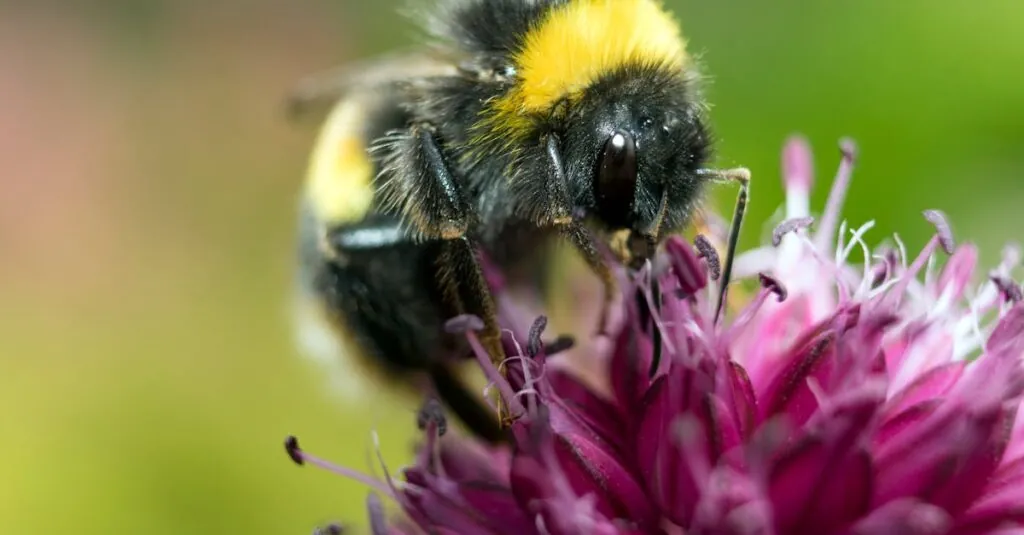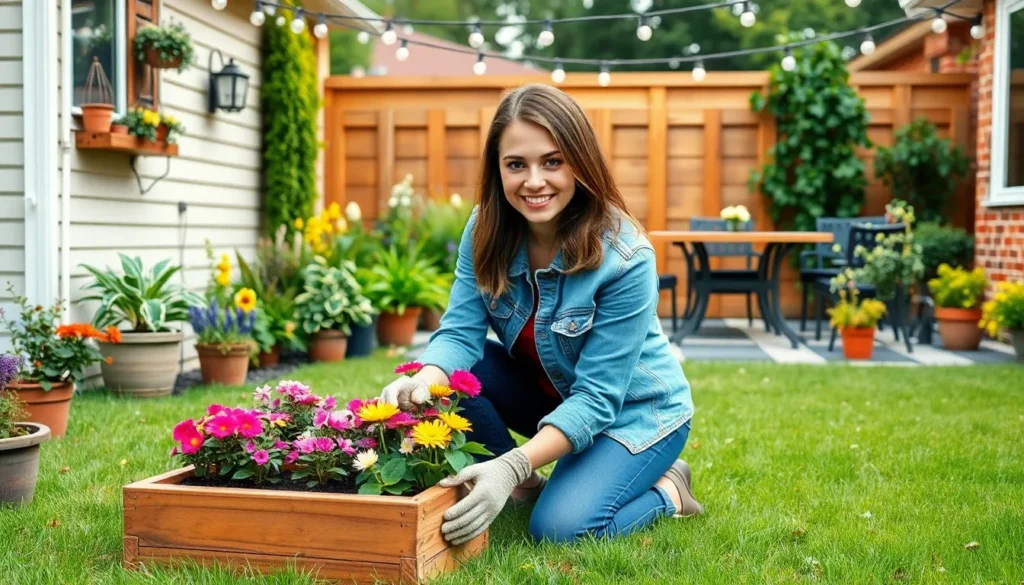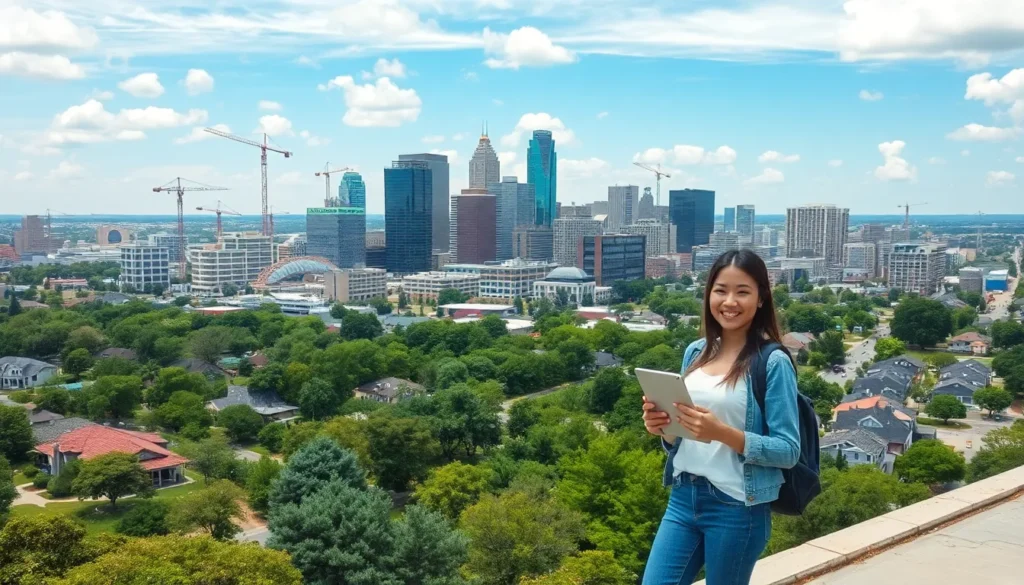Imagine stepping into a vibrant wildflower garden area, where colors dance and fragrances flirt with the senses. It’s not just a feast for the eyes; it’s a sanctuary for bees, butterflies, and anyone who appreciates nature’s confetti. Creating this paradise isn’t just about planting seeds; it’s about cultivating joy and a little bit of chaos—because who doesn’t love a garden that looks like it threw a party?
Table of Contents
ToggleOverview of Wildflower Garden Areas
A wildflower garden area showcases a diverse array of native flowers that bloom in colorful patches. This diversity creates visual appeal and contributes to local biodiversity. Pollinators thrive in these vibrant environments, with species like bees and butterflies benefiting from various nectar sources.
Such gardens require minimal maintenance once established. Selecting native plants ensures resilience against local pests and diseases. Careful planning maximizes blooming periods, facilitating continuous beauty from spring to fall. The garden design allows for spontaneous growth, which adds a delightful sense of nature’s unpredictability.
Wildflower garden areas can be created in various settings, including backyards, community spaces, or even urban environments. Each of these spaces offers unique opportunities for engagement with nature. Gardeners can observe wildlife interactions, promoting ecological awareness and appreciation.
Climate adaptability is crucial for wildflower gardens. Different regions support specific plant species that perform best in local conditions. Utilizing local knowledge aids in selecting appropriate flora, enhancing the garden’s success.
Soil preparation plays a vital role in establishing a successful wildflower garden. Testing soil pH and nutrient levels leads to informed decisions about amendments required for optimal growth. Gardeners should ensure good drainage to support root development, essential for plant health.
Incorporating paths or seating areas can enhance garden enjoyment. Visitors can relax and observe the beauty surrounding them. This thoughtful integration encourages a deeper connection to the landscape.
Benefits of Wildflower Garden Areas
Wildflower garden areas offer numerous benefits that enhance both the environment and visual appeal. They contribute significantly to ecological health and aesthetic enjoyment.
Environmental Impact
Wildflower gardens support biodiversity by attracting various insects and wildlife, particularly pollinators like bees and butterflies. These gardens require less water than traditional lawns due to the drought resistance of many native plants. They also help reduce soil erosion by stabilizing soils with their extensive root systems. Additionally, wildflower gardens improve air quality by absorbing carbon dioxide and releasing oxygen. They provide habitats for native wildlife, promoting ecological balance in local ecosystems. Establishing these gardens fosters community awareness about native species and their importance, creating a more environmentally conscious society.
Aesthetic Appeal
Wildflower gardens add vibrant colors and textures that enhance any landscape. They create a dynamic visual display, with flowers blooming at different times throughout the seasons. This continuous array of color offers visual interest from spring through fall. Visitors frequently enjoy the naturalistic look of these gardens, which contrast sharply with manicured lawns. Varieties of shapes and sizes evoke a sense of whimsy and spontaneity, inviting exploration. Incorporating paths or seating areas within the garden creates inviting spaces for relaxation and contemplation. Observing the natural beauty in a wildflower garden can provide a calming experience that nurtures one’s connection to nature.
Designing a Wildflower Garden Area
Designing a wildflower garden area involves thoughtful planning to create a vibrant and inviting space. The key steps include choosing a suitable location and selecting the right native species.
Choosing the Right Location
Selecting the right location sets the foundation for successful wildflower gardens. Locations with full sun exposure offer the best conditions for growth, while well-drained soil contributes to healthy root systems. Areas with ample space allow for a mix of flowers, promoting a natural ecosystem. Proximity to other plants can attract beneficial insects. Additionally, avoiding places with heavy foot traffic protects delicate blooms. Consideration of wind exposure also plays a role, as sheltered areas can prevent damage during storms. By evaluating these factors, a garden thrives in its environment.
Selecting Native Wildflower Species
Choosing native wildflower species enhances the garden’s ecological benefits. These plants adapt well to local conditions, resulting in lower maintenance efforts. The variety of native flowers ensures continuous blooming throughout different seasons. Plants such as coneflowers, black-eyed Susans, and lupines attract pollinators like bees and butterflies, enriching biodiversity. Gardeners should also consider bloom time to achieve a stunning display. Local extension services or native plant societies provide valuable resources for selecting species. By focusing on native flowers, gardens reflect the region’s natural heritage while supporting wildlife.
Maintenance Tips for Wildflower Gardens
Maintaining a wildflower garden area involves specific practices that promote health and vibrancy. Consistency in these practices helps achieve a flourishing landscape.
Watering and Soil Care
Watering plays an important role in establishing wildflowers, especially during their first growing season. Regularly check the moisture level of the soil; it should be damp but not waterlogged. Native plants often require less frequent watering once established. Soil care involves testing pH levels, aiming for a range of 6.0 to 7.0 for optimal growth. Additional organic matter, like compost, enhances soil quality and supports plant health. Adequate drainage is crucial; ensure the garden area doesn’t retain excess water. Avoid over-fertilizing, as native plants thrive without heavy nutrient inputs.
Managing Weeds and Pests
Weeds can compete with wildflowers for nutrients and water, so monitoring growth is essential. Hand-pulling or mulching can control weed populations without harming native species. Pest management requires observing plants carefully to catch infestations early. Beneficial insects, such as ladybugs, naturally keep pest levels in check. If necessary, use organic insecticidal soap to treat minor outbreaks, always opting for gentle solutions. Regular maintenance tasks, such as deadheading spent blooms, improve aesthetics and encourage continued flowering. Recognizing the balance of the ecosystem allows wildflower gardens to flourish in all their natural beauty.
Conclusion
Creating a wildflower garden area is a rewarding endeavor that enriches both personal spaces and the environment. These gardens not only enhance the aesthetic appeal of any setting but also play a crucial role in supporting local ecosystems. By embracing native plants and allowing for a bit of natural spontaneity, gardeners can cultivate vibrant spaces that attract pollinators and wildlife.
With minimal maintenance once established, wildflower gardens offer a sustainable alternative to traditional lawns. They invite exploration and provide a serene escape into nature, fostering a deeper connection with the environment. Ultimately, a wildflower garden serves as a celebration of biodiversity and beauty, transforming any area into a lively and colorful sanctuary.













